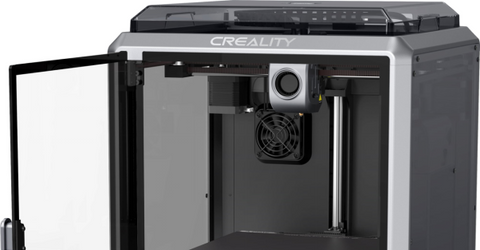
Den richtigen 3D-Drucker für Ihre Anforderungen zu finden, kann eine gewaltige Aufgabe sein, insbesondere angesichts der vielen Optionen auf dem Markt. Zwei beliebte Optionen, die in Diskussionen häufig auftauchen, sind der Bambulab P1P und der Creality K1C. Beide Drucker bieten einzigartige Funktionen und Fähigkeiten, die unterschiedliche Anforderungen erfüllen. In diesem umfassenden Vergleich werden wir uns mit den wichtigsten Spezifikationen, der Leistung und dem allgemeinen Benutzererlebnis beider Drucker befassen, damit Sie eine fundierte Entscheidung treffen können. Egal, ob Sie ein Profi sind, der nach dem besten Drucker für Ihr Unternehmen sucht, oder ein Hobbyist, der neue Möglichkeiten erkundet, lesen Sie weiter, um die Unterschiede zwischen dem Bambulab P1P und dem Creality K1C zu entdecken.
Funktionen und Spezifikationen von Bambulab P1P

Der Bambulab P1P ist ein 3D-Drucker mit vielen Funktionen und einer Reihe von Spezifikationen, die sowohl die Anforderungen von Profis als auch von Hobbybastlern erfüllen. Mit einem großzügigen Bauvolumen von 256 x 256 x 256 mm bietet er viel Platz, um Ihre kreativen Ideen zum Leben zu erwecken. Der Drucker zeichnet sich durch seine Geschwindigkeit aus und verfügt über eine beeindruckende maximale Druckgeschwindigkeit von bis zu 500 mm/s, was eine effiziente und zeitnahe Produktion Ihrer Designs ermöglicht.

Der Bambulab P1P ist mit einem stabilen Aluminiumrahmen ausgestattet, der Stabilität und Präzision während des gesamten Druckvorgangs gewährleistet. Darüber hinaus verfügt er über einen hochauflösenden LCD-Bildschirm mit einer benutzerfreundlichen Oberfläche für einfache Navigation und Steuerung. Dank seiner Kompatibilität mit einer Vielzahl von Filamenten, darunter PLA, ABS und PETG, bietet der Bambulab P1P Vielseitigkeit bei der Materialauswahl.
Funktionen und Spezifikationen von Creality K1C

Der Creality K1C ist ein leistungsstarker 3D-Drucker, der sowohl für den professionellen als auch für den Anfängergebrauch konzipiert ist. Sein großzügiges Bauvolumen von 220 x 220 x 250 mm ermöglicht die Erstellung großer und detaillierter Objekte. Der K1C legt Wert auf Druckgeschwindigkeit und Genauigkeit und sorgt so für effiziente und qualitativ hochwertige Ergebnisse. Ein robuster Aluminiumrahmen garantiert Stabilität während des gesamten Druckvorgangs. Eine intuitive Touchscreen-Oberfläche vereinfacht die Bedienung und macht ihn für alle Erfahrungsstufen benutzerfreundlich. Darüber hinaus eignet sich der K1C hervorragend für die Verarbeitung einer Vielzahl von Filamenten, darunter PLA, ABS, TPU und insbesondere kohlenstofffaserverstärkte Filamente, und bietet so eine außergewöhnliche Materialvielfalt für Ihre Projekte. Bleiben Sie dran, während wir untersuchen, wie sich die Funktionen des K1C im Vergleich zum Bambulab P1P schlagen.
Ist Bambu Lab besser als Creality?
Fühlen Sie sich von der großen Auswahl an 3D-Druckern auf dem Markt überwältigt? Keine Sorge, Sie sind nicht allein! Zwei führende Marken, Bambu Lab und Creality, sind beliebte Optionen, aber die Wahl des richtigen Modells hängt davon ab, was Sie erreichen möchten. Beide bieten hervorragende Geräte, aber sie sind auf unterschiedliche Arten von Herstellern ausgerichtet.

Bei Bambu Lab dreht sich alles darum, 3D-Druck einfach und effizient zu machen. Ihre Benutzeroberflächen sind unglaublich intuitiv und ihre Drucker lassen sich nahtlos in Filamentmanagementsysteme integrieren, sodass Sie sich keine Gedanken mehr machen müssen. Außerdem bieten sie blitzschnelle Druckgeschwindigkeiten – bis zu 500 mm/s –, was die Wartezeiten erheblich verkürzen kann. Wenn Sie ehrgeizige Projekte im Sinn haben, bietet Bambu Lab oft Drucker mit großzügigem Bauvolumen an, die Ihnen mehr Raum zum Gestalten geben. Diese erweiterten Funktionen haben jedoch ihren Preis, und die Closed-Source-Firmware von Bambu Lab ist möglicherweise nicht ideal für Bastler, die ihre Maschinen gerne anpassen.

Creality hingegen bietet eine größere Auswahl an Druckern in verschiedenen Preisklassen. Dies macht sie zu einer fantastischen Option für preisbewusste Anfänger oder alle, die gerade erst mit dem 3D-Druck beginnen. Ein großer Vorteil der Creality-Drucker ist ihre Open-Source-Firmware. Dadurch können erfahrene Benutzer tiefer eintauchen und Einstellungen feinabstimmen, was ihnen mehr Kontrolle über den Druckvorgang gibt. Während die Benutzeroberflächen von Creality im Vergleich zu Bambu Lab etwas gewöhnungsbedürftiger sein können, kann das Anpassungspotenzial ein großes Plus sein. Es ist auch erwähnenswert, dass Creality-Drucker möglicherweise etwas langsamere Druckgeschwindigkeiten haben als die Topmodelle von Bambu Lab.
|
Abhängig von Ihren spezifischen Anforderungen sind noch einige weitere Dinge zu berücksichtigen. Wenn Sie mit Hochtemperaturfilamenten wie ABS oder Nylon drucken möchten, ist Crealitys K1C mit seiner vollständig geschlossenen Kammer möglicherweise die bessere Wahl. In Bezug auf die Filamentkompatibilität bieten beide Marken Unterstützung für gängige Filamente wie PLA, ABS und PETG, aber der K1C geht noch einen Schritt weiter. Er kann problemlos mit flexiblen TPU-Filamenten umgehen und zeichnet sich sogar durch kohlenstofffaserverstärkte Filamente aus, was für einige Bambu Lab-Drucker schwierig sein kann.
Schlussfolgerung und Empfehlung
Die Wahl des richtigen 3D-Druckers kann eine gewaltige Aufgabe sein. Sowohl Bambu Lab als auch Creality bieten hervorragende Maschinen an, aber sie zeichnen sich in unterschiedlichen Bereichen aus. Hier ist eine kurze Zusammenfassung, die Ihnen die Entscheidung erleichtern soll:
Für Geschwindigkeitsfanatiker und Technikbegeisterte: Wenn modernste Funktionen, benutzerfreundliche Schnittstellen und blitzschnelle Druckgeschwindigkeiten Ihre obersten Prioritäten sind, könnte Bambu Lab genau das Richtige für Sie sein. Die größeren Bauvolumen und integrierten Ökosysteme sind für anspruchsvolle Projekte geeignet. Seien Sie jedoch auf einen höheren Preis und ein Closed-Source-System gefasst.
Für preisbewusste Maker und Bastler: Wenn Ihnen Erschwinglichkeit, Open-Source-Anpassung und breitere Filamentkompatibilität wichtig sind, könnte Creality die richtige Wahl sein. Ihr umfangreiches Sortiment bietet Optionen für Anfänger und erfahrene Benutzer gleichermaßen. Die Möglichkeit, sich in Einstellungen und Modifikationen zu vertiefen, macht sie ideal für diejenigen, die gerne basteln. Die Benutzeroberflächen von Creality erfordern jedoch möglicherweise etwas mehr Einarbeitung und ihre Druckgeschwindigkeiten können etwas langsamer sein als die der Topmodelle von Bambu Lab.
Letztendlich hängt die beste Wahl von Ihren individuellen Anforderungen und Druckzielen ab. Überlegen Sie, welche Funktionen für Sie am wichtigsten sind, ob Sie Benutzerfreundlichkeit oder Anpassung priorisieren, und wägen Sie das Budget gegen die gewünschte Funktionalität ab. Mit sorgfältiger Überlegung finden Sie den perfekten 3D-Drucker, um Ihrer Kreativität freien Lauf zu lassen und Ihre Ideen zum Leben zu erwecken!

